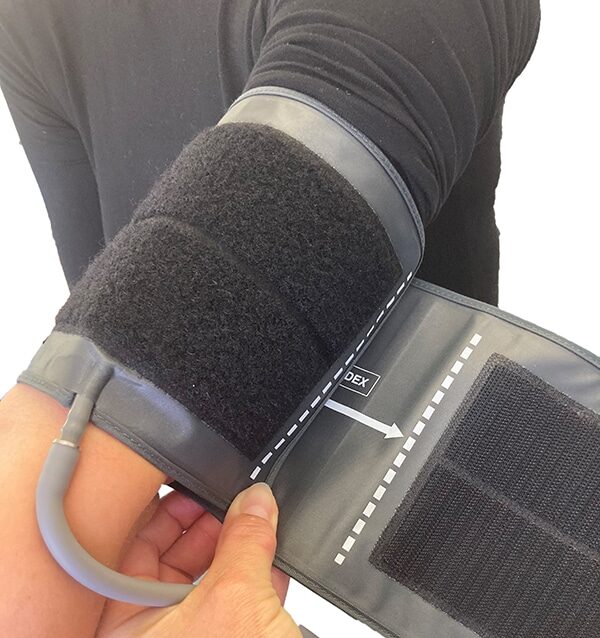The positive Value of Continuous Noninvasive Blood Pressure Monitoring compared to Intermittent Upper Arm Measurement
Comparison of hemodynamic stability with continuous noninvasive blood pressure monitoring and intermittent oscillometric blood pressure monitoring in hospitalized patients: A brand new systematic review and meta-analysis by Rajarathinam et al. 1

The American Society of Anesthesiologists recommends vital sign monitoring at least every 5 min to maintain the standard of care in perioperative settings1. The commonly used non-invasive method to meet this requirement is the monitoring with an intermittent oscillometric noninvasive BP (NIBP) cuff which automatically measures at certain time points. As an early detection of low or high BP events is crucial for perioperative management, this method may be insufficient for tracking important BP changes in time.
In critically ill patients or major surgeries invasive blood pressure (BP) monitoring to obtain beat-to-beat values is the gold standard, but is repeatedly associated with complications1. For lower-risk surgeries, invasive continuous monitoring is not justified because of potential risks, although undetected intraoperative hypotension has been associated with poor outcomes in various studies including kidney and organ injury, myocardial injury and inhospital mortality.


Continuous blood pressure measurement: Invasive Gold Standard and noninvasive finger sensor technologies
Recent evidence showed that an intraoperative mean ABP of <80 mm for more than 10 min may result in organ injury2. Continuous measurement may contribute to improve outcome in such settings. Noninvasive monitoring devices that can measure continuous BP will be ideal to fill the gap between invasive arterial and intermittent oscillometric NIBP.
Latest research confirms the benefit of continuous noninvasive techniques over intermittent oscillometric techniques. The aim of a new systematic review and meta-analysis was to analyze the advantages of continuous noninvasive BP (NIBP) monitoring compared to intermittent oscillometric NIBP monitoring1. Six randomized controlled trials (RCTs) with 686 surgical patients and six observational studies in various surgical indications were included and focused on the hemodynamic outcomes regarding:
- primary objectives, i.e. the incidence of hypotension and hypertension
- secondary objectives, i.e. duration of hypotension or hypertension and BP outside the normal clinical range, time to detect hypotension and/or hypertension
The results show different aspects of the advantages with the usage of noninvasive continuous monitoring which can result in a positive contribution in postoperative recovery. Five out of the six RCTs reported a decrease in the incidence of hypotension. The patients monitored with continuous NIBP monitoring had 75% lower odds of having hypotension.
Five of the six observational studies explored the ability of the continuous non-invasive measurement to detect hypotensive episodes compared to the standard NIBP monitoring in various settings such as endoscopies, cesarean sections, and ED and observed better detection of hypotensive episodes: “The time to detect hypotension was at least 1.5 min earlier with the continuous NIBP monitoring.”
In conclusion, continuous noninvasive measurement improves hemodynamic stability in surgical patients and allows for:
- decrease in the incidence of hypotension and hypertension
- reduction of the duration of hypotension
- decreased duration of BP outside normal range by up to the half
- earlier detection of hypotension

The advantage of a quicker detection of hypotension due to real-time monitoring enables the initiation of timely remedial measures to stabilize the blood pressure. This may lead to significantly less hypotensive episodes during surgery compared to intermittent NIBP. Noninvasive continuous finger cuff methods were shortening the duration of hypotension and hemodynamic instability by detecting episodes earlier, than by intermittent NIBP monitoring. The authors concluded that “The findings of this review and the individual studies show the promising value of continuous non-invasive measurement in selected clinical settings, where it can improve patient care and safety. This, in addition to the improvement of the monitoring algorithms and measurement performance in these new devices, is more likely to change the future of hemodynamic monitoring in acute care settings.”.
References:
[1] Rajarathinam, M. et al. Comparison of hemodynamic stability with continuous noninvasive blood pressure monitoring and intermittent oscillometric blood pressure monitoring in hospitalized patients: A systematic review and meta-analysis. Anesth. Essays Res. 0, 0 (2023)
[2] Wesselink, E. M., Kappen, T. H., Torn, H. M., Slooter, A. J. C. & van Klei, W. A. Intraoperative hypotension and the risk of postoperative adverse outcomes: a systematic review. Br. J. Anaesth. 121, 706–721 (2018)
Pictures/Graphics by CNSystems and Adobe Stock


